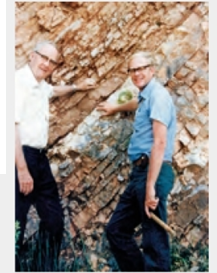
Concept explainers
Discovery of Iridium in the K–Pg Boundary Layer In the late 1970s, geologist Walter Alvarez was investigating the composition of the K–Pg boundary layer in different parts of the world. He asked his father, Nobel Prize–winning physicist Luis Alvarez, to help him analyze the elemental composition of the layer. The Alvarezes and their colleagues tested the K-Pg boundary layer in Italy and Denmark, and discovered that it contains a much higher iridium content than the surrounding rode layers (FIGURE 16.17). Iridium belongs to a group of elements that are much more abundant in asteroids and other solar system materials than they are in Earth’s crust. The Alvarez group concluded that the K–Pg boundary layer must have originated with extraterrestrial material.
| Sample Depth | Average Abundance of Iridium (ppb) |
| +2.7m | <0.3 |
| +1.2m | <0.3 |
| +0.7m | 0.36 |
| boundary layer | 41.6 |
| –0.5 m | 0.25 |
| –5.4 m | 0.30 |

FIGURE 16.17 Abundance of iridium in and near the K–Pg boundary layer.
Iridium content of rock samples above, below, and at the K–Pg boundary layer in Stevns Klint, Denmark. Sample depths are given as meters above or below the layer. ppb, parts per billion. An average Earth rock contains 0.4 ppb iridium; the average meteorite, 550 ppb. The photo shows Luis and Walter Alverez next to the K–Pg boundary layer in Stevns Klint.
What was the iridium content of the K–Pg boundary layer?
To determine: The iridium content of the K–Pg boundary layer.
Introduction: The iridium is a chemical element that is abundantly found in the Cretaceous–Paleogene (K–Pg) boundary layer. The iridium level in an average rock is about 0.4 ppb, and in an average meteorite, it is about 550 ppb. This allows scientists to conclude whether the origin of the rocks is from the Earth or from any other sources.
Explanation of Solution
As given in the problem statement, Researcher W examined the composition of the K–Pg boundary layer in various parts of the world. He took help from his father to examine the composition of elements in the layer. Researcher L and his colleagues tested the K–Pg boundary layer in Country D and Country I. They discovered that the iridium content was found to be in large quantity than the surrounding rock layers. They also concluded that the boundary layer may have originated with the extraterrestrial material.
Refer to Fig. 16.17, “Abundance of iridium in and near the K-Pg boundary layer”, in the textbook. The given table shows the average abundance of iridium (ppb), and the sample depth (in meters) in Country D. The chemical element iridium was found in abundance on an average of about 41.6 ppb in the K–Pg boundary layer.
The iridium content was 41.6 ppb in the K–Pg boundary layer.
Want to see more full solutions like this?
Chapter 16 Solutions
Biology: The Unity and Diversity of Life (MindTap Course List)
Additional Science Textbook Solutions
Genetics: From Genes to Genomes
Biological Science (6th Edition)
Laboratory Manual For Human Anatomy & Physiology
Campbell Biology in Focus (2nd Edition)
Chemistry: Structure and Properties (2nd Edition)
- 1. Match each vocabulary term to its best descriptor A. affinity B. efficacy C. inert D. mimic E. how drugs move through body F. how drugs bind Kd Bmax Agonist Antagonist Pharmacokinetics Pharmacodynamicsarrow_forward50 mg dose of a drug is given orally to a patient. The bioavailability of the drug is 0.2. What is the volume of distribution of the drug if the plasma concentration is 1 mg/L? Be sure to provide units.arrow_forwardDetermine Kd and Bmax from the following Scatchard plot. Make sure to include units.arrow_forward
- Choose a catecholamine neurotransmitter and describe/draw the components of the synapse important for its signaling including synthesis, packaging into vesicles, receptors, transporters/degradative enzymes. Describe 2 drugs that can act on this system.arrow_forwardThe following figure is from Caterina et al. The capsaicin receptor: a heat activated ion channel in the pain pathway. Nature, 1997. Black boxes indicate capsaicin, white circles indicate resinferatoxin. a) Which has a higher potency? b) Which is has a higher efficacy? c) What is the approximate Kd of capsaicin in uM? (you can round to the nearest power of 10)arrow_forwardWhat is the rate-limiting-step for serotonin synthesis?arrow_forward
 Biology Today and Tomorrow without Physiology (Mi...BiologyISBN:9781305117396Author:Cecie Starr, Christine Evers, Lisa StarrPublisher:Cengage Learning
Biology Today and Tomorrow without Physiology (Mi...BiologyISBN:9781305117396Author:Cecie Starr, Christine Evers, Lisa StarrPublisher:Cengage Learning Biology: The Unity and Diversity of Life (MindTap...BiologyISBN:9781337408332Author:Cecie Starr, Ralph Taggart, Christine Evers, Lisa StarrPublisher:Cengage Learning
Biology: The Unity and Diversity of Life (MindTap...BiologyISBN:9781337408332Author:Cecie Starr, Ralph Taggart, Christine Evers, Lisa StarrPublisher:Cengage Learning Biology: The Unity and Diversity of Life (MindTap...BiologyISBN:9781305073951Author:Cecie Starr, Ralph Taggart, Christine Evers, Lisa StarrPublisher:Cengage Learning
Biology: The Unity and Diversity of Life (MindTap...BiologyISBN:9781305073951Author:Cecie Starr, Ralph Taggart, Christine Evers, Lisa StarrPublisher:Cengage Learning
 Biology 2eBiologyISBN:9781947172517Author:Matthew Douglas, Jung Choi, Mary Ann ClarkPublisher:OpenStax
Biology 2eBiologyISBN:9781947172517Author:Matthew Douglas, Jung Choi, Mary Ann ClarkPublisher:OpenStax





